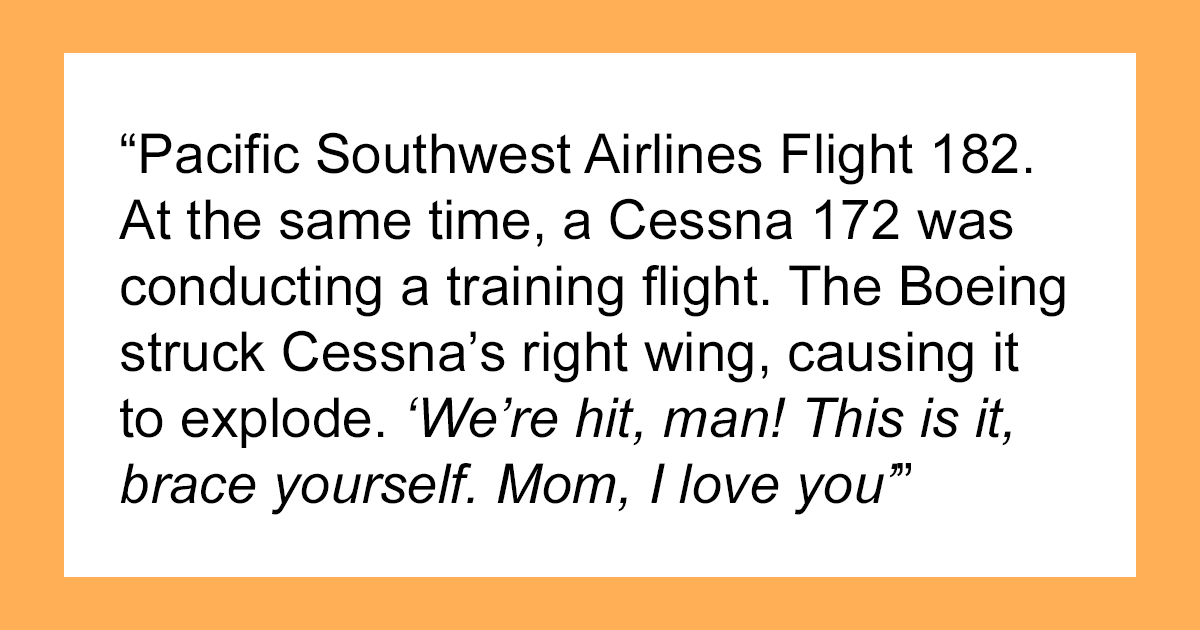14 Heart-Stopping Pilot Confessions Moments Before Disaster Strikes in the Sky
Ever wondered what goes through a pilot’s mind when things go terribly, eerily wrong up in the air? Picture this: you’re miles above the clouds, cruising along, when suddenly the cockpit voices turn from routine checks to chilling last words—heart-stopping, gripping, utterly real. While most flights land safely, some edge dangerously close to disaster, their final moments captured in raw audio that’s as haunting as it is electrifying. If you’ve ever found yourself a bit too wired on a flight, or if you’re bracing for one soon, these eye-opening transcripts might just have you gripping your armrest a little tighter… Ready to peer into the cockpit’s most unsettling moments where fate hangs by a thread? Dive in, and maybe keep a lucky charm handy! LEARN MORE.
One of the scariest things that can happen to you is being in an emergency situation while flying. While the absolute majority of pilots can get everything under control and get their passengers to their destinations safely, not everyone is as lucky.
Sometimes, disaster strikes. The ‘Echoes’ (@echoesstoriess) YouTube channel has featured some of the most terrifying things that pilots have said right before tragedy struck. Today, we’re sharing the most frightening real audio transcripts with you. You’ll find them as you scroll down.
A small note of warning: you might want to avoid these stories if you have aerophobia or if you’ve got a flight coming up this week.
 April 10th, 2010, Air Force Flight 101 was set to fly from Warsaw, Poland, to Smolensk, Russia. On board the Polish TU-154M were 96 people, including the then president of Poland, Lech Kaczynski, and his wife, Maria, along with other top government members and parliamentarians. They were heading to a ceremony commemorating the 70th anniversary of the Katyn massacre.
April 10th, 2010, Air Force Flight 101 was set to fly from Warsaw, Poland, to Smolensk, Russia. On board the Polish TU-154M were 96 people, including the then president of Poland, Lech Kaczynski, and his wife, Maria, along with other top government members and parliamentarians. They were heading to a ceremony commemorating the 70th anniversary of the Katyn massacre.
the plane had recently undergone repairs, and technicians guaranteed its full functionality. Its Captain, Arkadiusz Protasiuk, had over 3,500 flight hours under his belt, so nothing indicated disaster. As flight 101 departed from Warsaw, Smolensk was unexpectedly blanketed in thick fog, reducing visibility to dangerously low levels. Air traffic controllers warned the Polish government plane’s crew of the worsening weather and suggested redirecting, however, the captain decided to attempt a test approach, despite visibility dropping to a critical 400m. instead of the required 16,000m.: “If it’s fine, we will try landing, but if weather conditions are bad, we will reascend and make a second Circle.”
The plane suddenly descended to a dangerously low altitude, veering far off the safe landing trajectory. “Pull up, pull up, re-ascend for the second Circle! F**k!” The plane clipped trees, flipped midair, and plummeted to the ground. The impact caused the fuselage to shatter, and it exploded. All 96 people on board lost their lives. Investigations concluded that the crew should never have attempted to land in such critical weather conditions.
Some of the main triggers of aerophobia include:
- News stories about crashes or violence on airplanes
- Turbulence
- Takeoff and landing
- Thinking about either fire or illness spreading through the plane
The fear of flying can be even worse when combined with other phobias. For instance, with acrophobia (the fear of heights), agoraphobia (the fear of leaving the house or not being able to escape from a place), anthropophobia (the fear of people), claustrophobia (the fear of crowded and confined spaces), and mysophobia (aka germaphobia, the fear of germs).
 September 25th, 1978, a Pacific Southwest Boeing 727-214 was making a routine commercial flight from Sacramento to San Diego with a stopover in Los Angeles. On board were 126 passengers and 7 crew members. The plane was captained by James E. McFaron, an experienced pilot with 17 years of service. As the Boeing headed to San Diego, something unexpected happened.
September 25th, 1978, a Pacific Southwest Boeing 727-214 was making a routine commercial flight from Sacramento to San Diego with a stopover in Los Angeles. On board were 126 passengers and 7 crew members. The plane was captained by James E. McFaron, an experienced pilot with 17 years of service. As the Boeing headed to San Diego, something unexpected happened.
At the same time, a Cessna 172, a single-engine plane with 2 people on board, was conducting a training flight. Air Traffic Control warned the Boeing crew that the Cessna was approaching from the East, “Yeah, but I don’t see him now.” “Okay, we had it there a minute ago.” Despite this, uncertainty filled the cockpit as Captain McFaron repeatedly asked, “Are we clear of that Cessna?” “Supposed to be, I guess, I hope.”
The Boeing received permission to land, and the pilots focused on preparing for descent. At this time, the controllers did not notice the planes approaching. Then, at 792., the passenger plane suddenly struck the Cessna’s right wing, causing it to explode. The Boeing’s wing sustained severe damage, igniting a fuel tank, and the plane began to fall. “We’re hit, man, we are hit! This is it, brace yourself. Mom, I love you.” These were the last words spoken before the airliner went into a steep dive and almost vertically crashed into the North Park residential area of San Diego. The tragedy claimed the lives of all 135 people aboard, both Pilots of the Cessna and 7 people on the ground.














